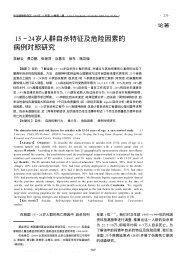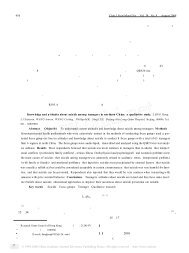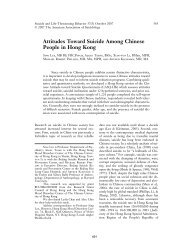Interventions for Suicide Survivors: A Review of the Literature
Interventions for Suicide Survivors: A Review of the Literature
Interventions for Suicide Survivors: A Review of the Literature
Create successful ePaper yourself
Turn your PDF publications into a flip-book with our unique Google optimized e-Paper software.
348 <strong>Interventions</strong> <strong>for</strong> <strong>Suicide</strong> <strong>Survivors</strong><br />
authorities versus survivors’ needs <strong>for</strong> support cry...Women do: Transcending gender stereotypes <strong>of</strong><br />
after suicide. Death Studies, 26, 647–668.<br />
grief. Philadelphia, PA: Taylor & Francis.<br />
Ellenbogen, S., & Gratton, F. (2001). McIntosh, J. L. (1999). Research on survi-<br />
Do <strong>the</strong>y suffer more? Reflections on research vors <strong>of</strong> suicide. In M. Stimming & M. Stimming<br />
comparing suicide survivors to o<strong>the</strong>r survivors. (Eds.), Be<strong>for</strong>e <strong>the</strong>ir time: Adult children’s experiences<br />
<strong>Suicide</strong> and Life-Threatening Behavior, 31, 83–90. <strong>of</strong> parental suicide (pp. 157–180). Philadelphia, PA:<br />
Farberow, N. (1992). The Los Angeles Temple University Press.<br />
survivors-after-suicide program: An evaluation. Mitchell, A., & Kim, Y. (2003). Debriefing<br />
Crisis, 13, 23–34. approach with suicide survivors. Paper presented at<br />
Farberow, N. (2001). Helping suicide sur- <strong>the</strong> <strong>Survivors</strong> <strong>of</strong> <strong>Suicide</strong> Research Workshop,<br />
vivors. In D. Lester (Ed.), <strong>Suicide</strong> prevention: Re- Washington, DC. Sponsored by <strong>the</strong> American<br />
sources <strong>for</strong> <strong>the</strong> millennium (pp. 189–212). Philadel- Foundation <strong>for</strong> <strong>Suicide</strong> Prevention and <strong>the</strong> Naphia,<br />
PA: Brunner-Routledge. tional Institute <strong>of</strong> Mental Health.<br />
Figley, C. (1997). Death and trauma: The<br />
Moscicki, E. K. (1995). Epidemiology <strong>of</strong><br />
traumatology <strong>of</strong> grieving. Philadelphia, PA: Taylor suicidal behavior. <strong>Suicide</strong> and Life-Threatening Be-<br />
& Francis.<br />
havior, 25, 22–35.<br />
Figley, C. (1999). Traumatology <strong>of</strong> grieving: Murphy, S. A. (2000). The use <strong>of</strong> research<br />
Conceptual, <strong>the</strong>oretical, and treatment foundations. findings in bereavement programs: A case study.<br />
Philadelphia, PA: Taylor & Francis. Death Studies, 24, 585–602.<br />
Fleming, S., & Robinson, P. (2001). Grief Murphy, S. A., Johnson, C., Cain, K. C.,<br />
and cognitive-behavioral <strong>the</strong>rapy: The reconstruc- Gupta, A. D., Dimond, M., Lohan, J., &<br />
tion <strong>of</strong> meaning. In M. S. Stroebe, R. O. Hansson, Baugher, R. (1998). Broad-spectrum group treat-<br />
W. Stroebe, & H. Schut (Eds.), Handbook <strong>of</strong> be- ment <strong>for</strong> parents bereaved by <strong>the</strong> violent deaths <strong>of</strong><br />
reavement research: Consequences, coping, and care <strong>the</strong>ir 12- to 28-year-old children: A randomized<br />
(pp. 647–670). Washington, DC: American Psy- controlled trial. Death Studies, 22, 209–235.<br />
chological Association.<br />
Murphy, S. A., Johnson, L. C., & Weber,<br />
Freeman, S. (1991). Group facilitation <strong>of</strong> N. A. (2002). Coping strategies following a child’s<br />
<strong>the</strong> grieving process with those bereaved by sui- violent death: How parents differ in <strong>the</strong>ir recide.<br />
Journal <strong>of</strong> Counseling & Development, 69, sponses. Omega, 45, 99–118.<br />
328–331.<br />
Murphy, S. A., Johnson, L. C., Wu, L.,<br />
Horowitz, S. H. (1997). Treating families Fan, J. J., & Lohan, J. (2003). Bereaved parents’<br />
with traumatic loss: Transitional family <strong>the</strong>rapy. In outcomes 4 to 60 months after <strong>the</strong>ir children’s<br />
C. Figley (Ed.), Death and trauma: The traumatol- deaths by accident, suicide, or homicide: A com-<br />
ogy <strong>of</strong> grieving (pp. 211–230). Philadelphia, PA: parative study demonstrating differences. Death<br />
Taylor & Francis. Studies, 27, 39–61.<br />
Jordan, J. R. (2001). Is suicide bereave-<br />
Neimeyer, R. A. (2000). Searching <strong>for</strong> <strong>the</strong><br />
ment different? A reassessment <strong>of</strong> <strong>the</strong> literature. meaning <strong>of</strong> meaning: Grief <strong>the</strong>rapy and <strong>the</strong><br />
<strong>Suicide</strong> and Life-Threatening Behavior, 31, 91–102. process <strong>of</strong> reconstruction. Death Studies, 24, 541–<br />
Jordan, J. R., & Neimeyer, R. A. (2003). 558.<br />
Does grief counseling work? Death Studies, 27, Pennebaker, J. W., Zech, E., & Rime, B.<br />
765–786. (2001). Disclosing and sharing emotion: Psycho-<br />
Juhnke, G. A., & Sh<strong>of</strong>fner, M. F. (1999). logical, social, and health consequences. In M. S.<br />
The family debriefing model: An adapted critical Stroebe, R. O. Hansson, W. Stroebe, & H. Schut<br />
incident stress debriefing <strong>for</strong> parents and older (Eds.), Handbook <strong>of</strong> bereavement research: Conse-<br />
sibling suicide survivors. The Family Journal: quences, coping, and care (pp. 517–544). Washing-<br />
Counseling and Therapy <strong>for</strong> Couples and Families, 7, ton, DC: American Psychological Association.<br />
342–348. Pfeffer, C. R., Jiang, H., Kakuma, T.,<br />
Kato, P. M., & Mann, T. (1999). A syn- Hwang, J., & Metsch, M. (2002). Group inter<strong>the</strong>sis<br />
<strong>of</strong> psychological interventions <strong>for</strong> <strong>the</strong> be- vention <strong>for</strong> children bereaved by <strong>the</strong> suicide <strong>of</strong> a<br />
reaved. Clinical Psychology <strong>Review</strong>, 19, 275–296. relative. Journal <strong>of</strong> <strong>the</strong> American Academy <strong>of</strong> Child<br />
Kovac, S., & Range, L. S. (2000). Writing and Adolescent Psychiatry, 41, 505–513.<br />
projects: Lessening undergraduates’ unique sui- Prigerson, H., & Jacobs, S. (2001). Traucidal<br />
bereavement. <strong>Suicide</strong> and Life-Threatening Be- matic grief as a distinct disorder: A rationale, con-<br />
havior, 30, 50–60.<br />
sensus, criteria, and a preliminary empirical test.<br />
Lambert, M. J., & Bergin, A. E. (1994). In M. S. Stroebe, R. O. Hansson, W. Stroebe, &<br />
The effectiveness <strong>of</strong> psycho<strong>the</strong>rapy. In A. E. Ber- H. Schut (Eds.), Handbook <strong>of</strong> bereavement research:<br />
gin & S. L. Garfield (Eds.), Handbook <strong>of</strong> psycho<strong>the</strong>r- Consequences, coping, and care (pp. 613–647). Wash-<br />
apy and behavior change (4 ington, DC: American Psychological Association.<br />
th ed., pp. 143–189). New<br />
York: Wiley. Provini, C., Everett, J. R., & Pfeffer, C.<br />
Martin, T., & Doka, K. (2000). Men don’t<br />
(2000). Adults mourning suicide: Self-reported

















